Namibia, situated in Southwest Africa, is a land of contrasts; a place where high sand dunes and desert sands meet the blue waters of the Atlantic ocean coast. The Namib Desert snakes along the desolate coastline with a few small, but well-established coastal resort towns in the southwest. Unusual plant life can be found in a few isolated areas while wildlife abounds on the salt pans of the Etosha National Park in the North. The country gained its independence in 1990. Indigenous tribes such as the Himba, Damara, and Herero still live traditional lives. German colonial buildings in the capital city of Windhoek, and the coastal town of Swakopmund display their heritage. Our Namibia road trip took us from Windhoek, exploring the southwestern areas of the country.
Day 1 of Our Namibia Road Trip: Arrival in Cosmopolitan Windhoek
We exited the Hosea Kutako International airport in our rental sedan car, admiring the bright blue sky and breathing in the vastness of Namibia. Our Namibia road trip was about to begin. The 25-mile open road to Windhoek, the capital city, stretched ahead of us. We were amazed at all the activity as we drove into Windhoek. Cars whizzed past and people crowded the streets. Modern structures, supermarkets, and restaurants blended easily with buildings featuring notably German architecture.
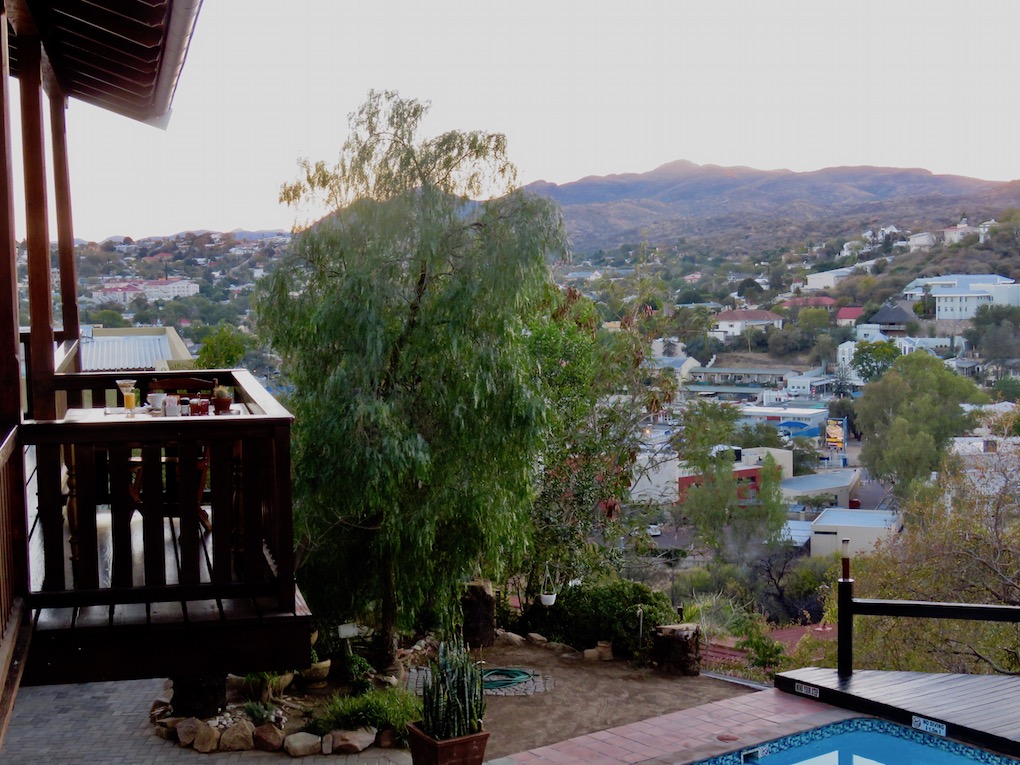
The Windhoek mountains from Guesthouse (Photo by Elsa Dixon)
After climbing an unexpected steep hill and negotiating a hairpin bend in the road, we settled into the Hilltop Guesthouse, overlooking the city and the Auas Mountains in the distance. We felt compelled to have dinner at the one landmark restaurant all the tour guides recommend: the iconic Joe’s Beerhouse.
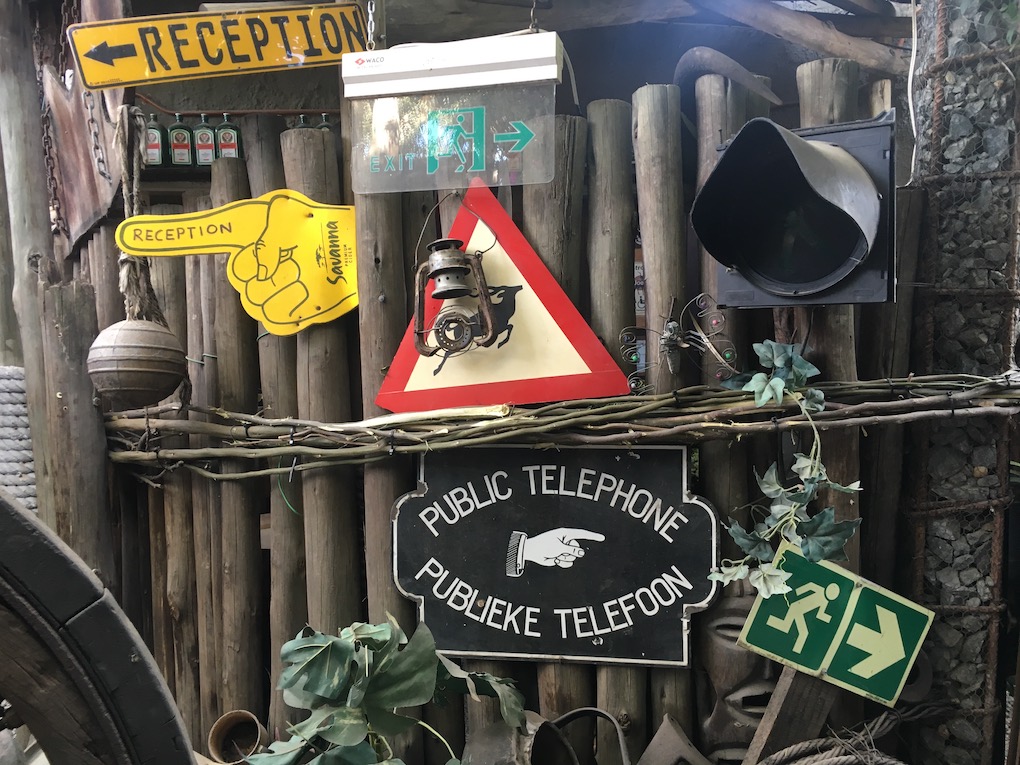
Joe’s Beerhouse (Photo by Elsa Dixon)
We spent about 20 minutes exploring the nook and cranny, every available space filled with memorabilia ranging from wheels to signposts, objects from the colonial days to taxidermied animal heads.
A Mini motor car perched on a bridge spanning the entrance. Two inveterate Portuguese travelers left it there having driven it from the east to the west coast. We certainly enjoyed choosing from the menu offering tantalizing dishes with German, Portuguese, South African, and local influences.
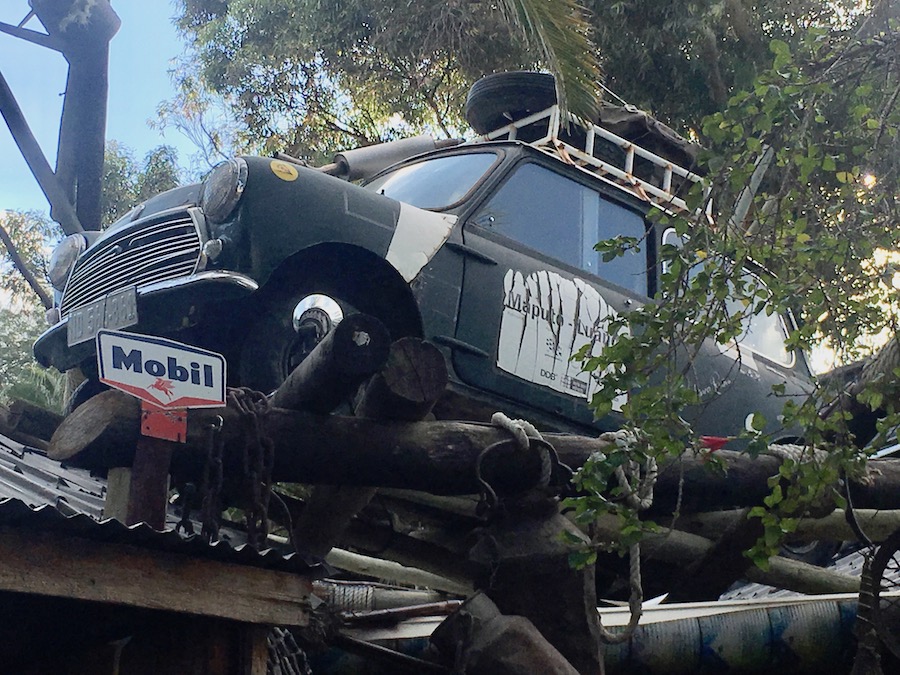
Joe’s car (Photo by Elsa Dixon)
Day 2: A Visit to The Independence Memorial Museum in Windhoek
We spent the morning exploring Windhoek, doing some shopping, having tea and a light lunch at a local restaurant in the town. German-speaking and African residents chatted together at the tables around us.
Our next stop was The Independence Memorial Museum on Robert Mugabe Avenue. Two colonial landmarks, the Christuskirche, and the Alte Feste flank the building. A statue of Sam Nujoma holding a copy of the Constituency Book welcomes one at the entrance. We accessed the glass-fronted elevator on the outside of the five-story building from where we saw stunning views of Windhoek.
The first floor in the Museum tells the story of the ‘Colonial Repression’ and the timeline under South African rule. The second floor, called ‘Liberation,’ commemorates the South African Border War and the role of the People’s Liberation Army of Namibia. The third floor details the ‘Road to Independence,’ and includes a platform from which one can view the Panoramic Hall. The Museum indeed told a complete story of Namibia’s struggle for Independence.
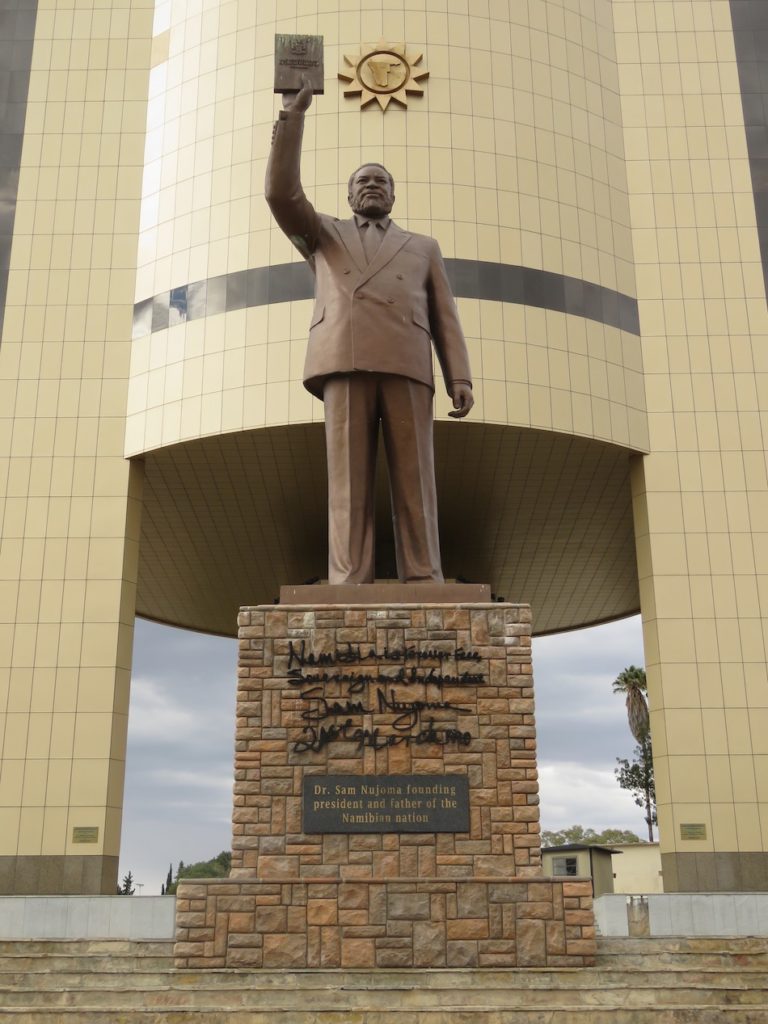
Statue of Sam Nujoma. Nujoma is an anti-apartheid activist who served three terms as the first President of Namibia (Photo Elsa Dixon)
Day 3: Driving from Windhoek to the Gondwana Namib Desert Lodge
Braving the chilly air early the next morning, we had an excellent breakfast on the balcony of the main guesthouse and then left on our road trip. We would travel in the direction of Walvis Bay to Solitaire, and then to our accommodation at the Namib Desert Lodge on the way to Sossusvlei and the dunes. Our Namibia road trip continued!
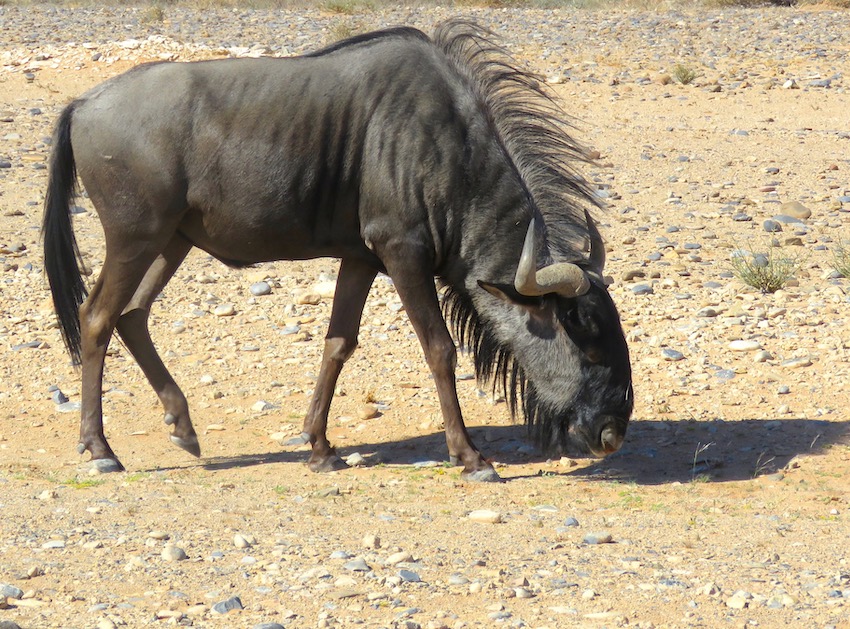
A blouwildebeest (Photo Elsa Dixon)
The tar road soon gave way to gravel and then to dirt. There was not another car in sight, but we relaxed and enjoyed the unexpected wildlife that popped up: a baboon, a buck, a blouwildebeest, a warthog, and a few mongooses. On occasion, we had to avoid cows on the road. Going through a mountain pass, we stopped to admire the starkness of the semi-desert and the impressive rock formations. Soon after, we began to see vast stretches of desert sand and small herds of zebra and gemsbok (oryx).
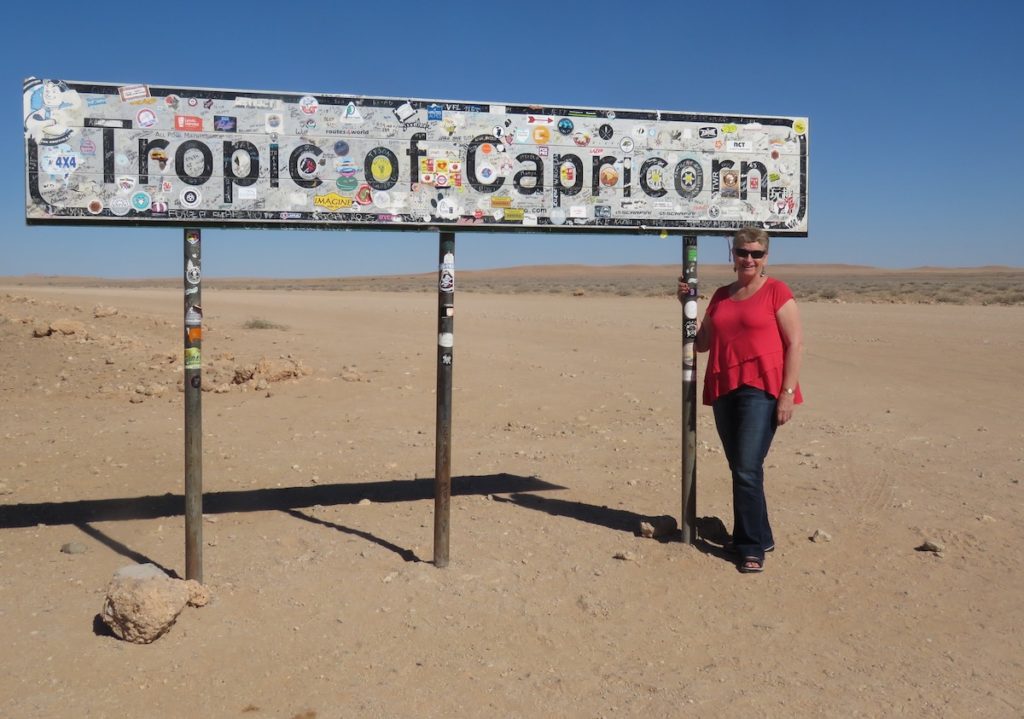
Standing at the Tropic of Capricorn
Then we hit miles of open plains. The monotony was broken by sudden activity at a signboard marking the Tropic of Capricorn. It is one of the five major circles of latitude, named for the Capricorn constellation rising above it on the summer solstice. We stopped to take the obligatory photos before pushing on to Solitaire for a very necessary fuel fill-up. Solitaire is the only gas station for 100 miles, and there were cars and trucks lined up. One could only wonder from where they all came. Solitaire is not much more than a small gas station, a convenience store, and a huge yard full of car skeletons. It is also famous for the legendary apple-pie at Moose McGregor’s Desert Bakery, and after a small sampling, we could see why.
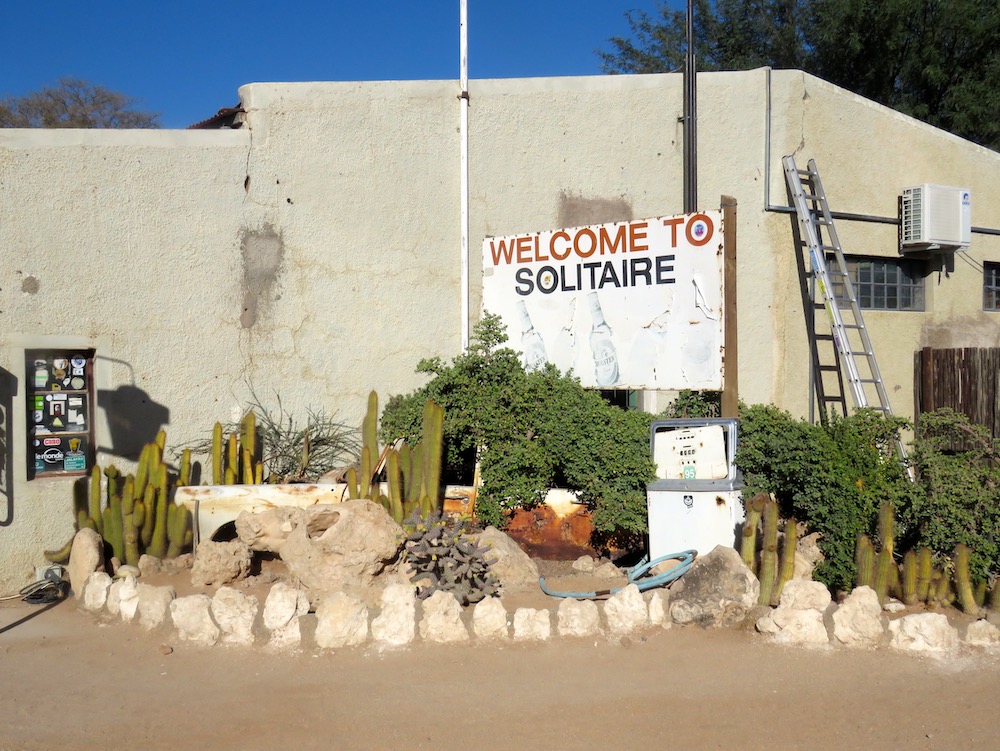
Welcome Solitaire (Photo Elsa Dixon)
Then it was on to our guest lodge, another 30 minutes of really bumpy roads and potholes. The Namib Desert Lodge loomed like an oasis against the backdrop of a ridge of fossiled red dunes. Situated at the center of a 62 square mile private reserve, the reception, restaurant and swimming pool areas extend to a series of ‘square-dawels’ joined by neatly laid out pathways. The room was very comfortable, and we even received a small little bottle of Namib sand as a welcome gift.
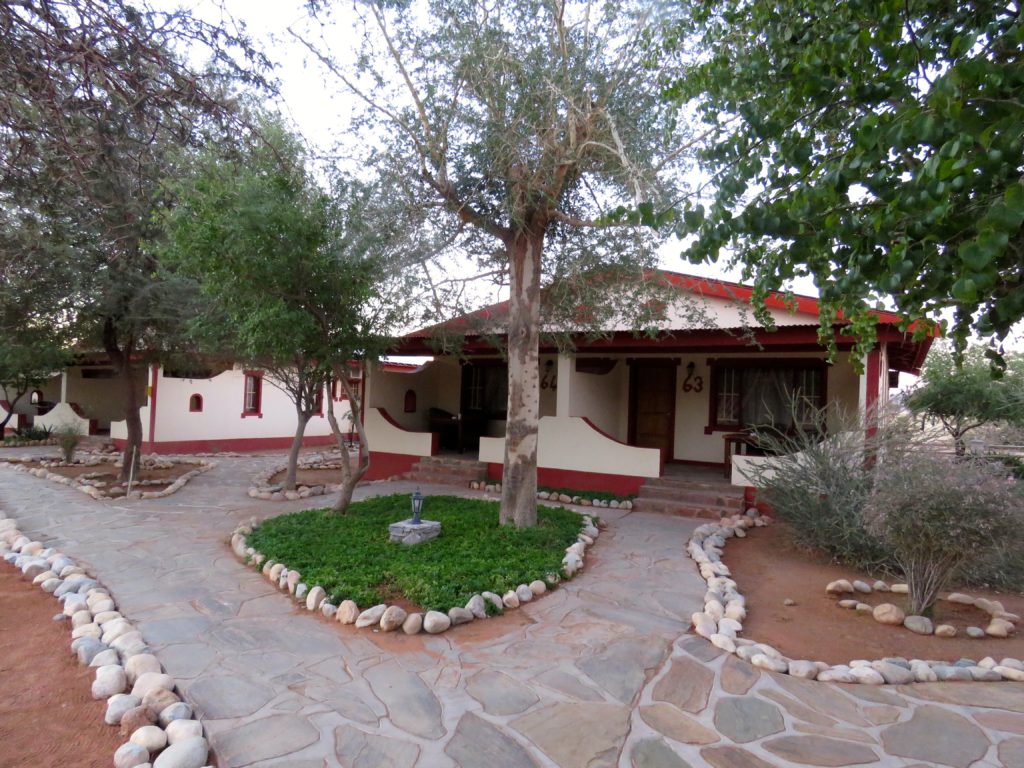
Chalets Lodge (Photo Elsa Dixon)
Day 4: The Magnificent Namib Desert Dunes
Very early morning, before dawn, we headed south for about 31 miles to Sesriem, a tiny village at the entrance of the Namib Naukluft National Park. Sesriem is the gateway to the red dunes of Sossusvlei, which in turn leads into the Greater Namib Desert. Sesriem boasts a cluster of lodges, a gas station, and a small convenience store.
The Sossusvlei Dunes, among the highest in the world, display their magnificent colors when the sun comes up. If you are staying outside the park, the main gate opens at sunrise and closes at sunset, therefore, not allowing enough time to reach the dunes. There is a second inner gate opening earlier before dawn and after dusk for guests inside the park to self-drive to the dunes. So, if you want to see the sunrise, you need to stay in the park at either the Sesriem Campsite or Sossus Dune Lodge. Book in advance is essential, especially during peak season, since space is limited.
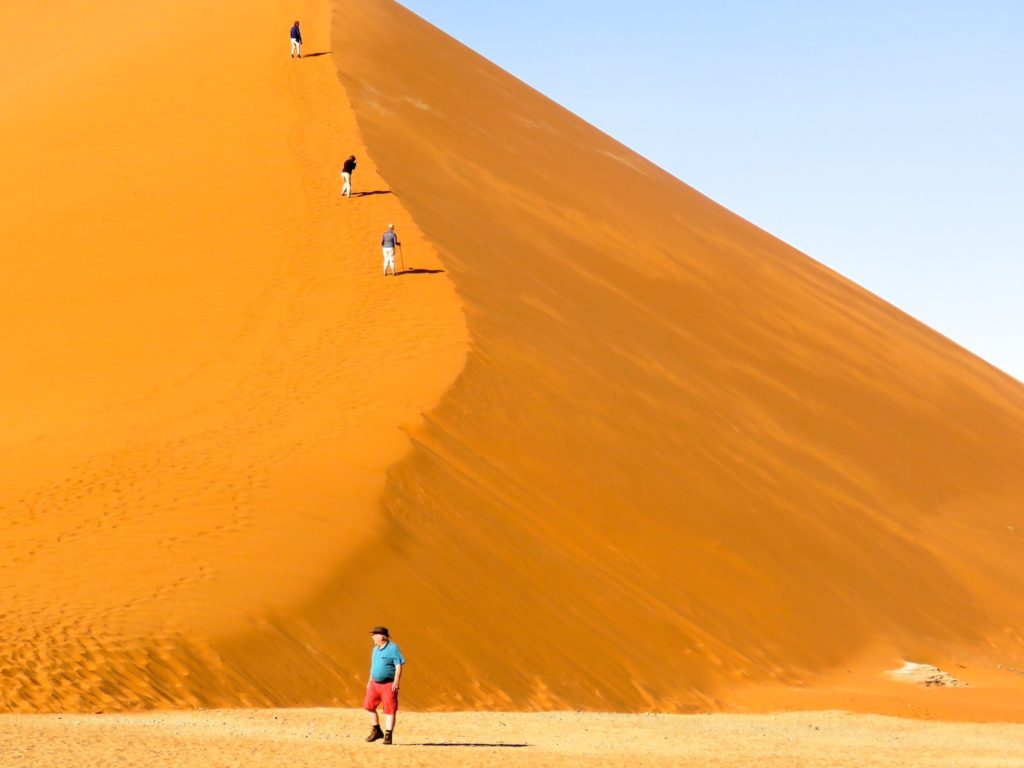
Sossusvlei Dunes, some of the highest in the world (Photo Elsa Dixon)
Keeping to the speed limit of 37 miles per hour, we drove about 30 minutes on an excellent tar road amidst a sea of dunes to reach Dune 45, the most photographed dune in the world. Along the way, we were delighted to see oryx and a blue wildebeest up close. Dune 45 gets its name from the 45 kilometers (30 miles) distance from the Sesriem Gate. It is hard to imagine that the sand is 5 million years old! Its red color is due to its iron oxide content. Since the wind in the Sossusvlei area blows from all directions, it causes the sand to form star shapes, hence the name ‘star dunes.’
Clad in closed shoes, and armed with hats, sunscreen, and water, my guests set off to conquer Dune 45. They spent about an hour climbing the 279 feet high dune to the top from where they took in the sheer expanse of Dune Valley.
What makes the dunes so unique? I would say the sheer scale and magnificence of these ‘oceans’ of sand. During early morning and evening light, the sun casts shadows over the dunes, and the colors keep changing. Throughout the day, the shifting sands produce ripples and patterns. Long lines of footprints create further special effects. There is also a silence that underlines the desolation of this area.
We left the car at the 2X4 parking area from where we would take the official 4X4 shuttles to reach the Deadvlei parking area. A sedan cannot negotiate the 3 miles of very thick sand. While I stayed in the cool of the ancient trees, my friends spent nearly two hours climbing the ‘Big Daddy’ dune. At 1066 feet, it is the tallest in this area. From the top, they had a beautiful view of Deadvlei, an eerie, dead marsh with 900-year-old camel thorn trees that cannot decompose because of the intense heat.
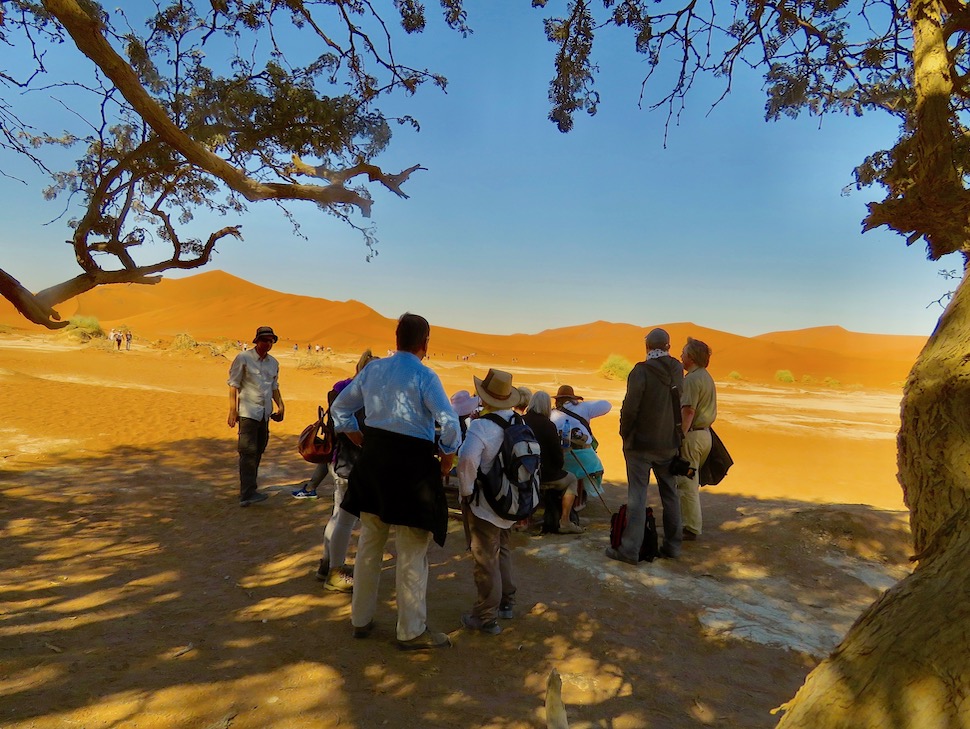
The Big Daddy Dune (Photo Elsa Dixon)
Our shuttle driver drove a little further to the Sossusvlei parking area, the end of the road. From here we could admire Big Mama, another favorite dune to climb. Sossusvlei is a Nama and Afrikaans word meaning ‘dead-end,’ referring to the salt and clay pan at the end of the Tsauchab River. However, it is often used to indicate the whole area up to Dune 45.
Back at the Namib Desert Lodge, we marveled at the fossilized dunes and the endless stars in the desert sky before enjoying another lovely dinner.
Day 5: Where Desert Sands Meet The Ocean
Early morning saw us back on ‘sandy tracks’ and rugged mountain roads and on our way to Walvis Bay. The drive through the Namib Desert on the C14 takes about 5 hours. The road winds through the Namib-Naukluft National Park, Africa’s largest conservation area, encompassing desert and mountains and moonlike landscapes. We stopped quite a few times for awe-inspiring photo opportunities. As we neared Walvis Bay, driving became surreal as desert sand virtually obliterated the tar road for miles on end.
We saw some strange sights, like a toilet perched on a hill, and then, a turn-off for Dune 7, about 4 miles from the harbor town. The Dune is so named because it is the 7th one past the Tsauchab River. We gingerly veered off the road through even deeper sand and watched some sand boarders come down this 1256 feet high dune, the tallest in the world.
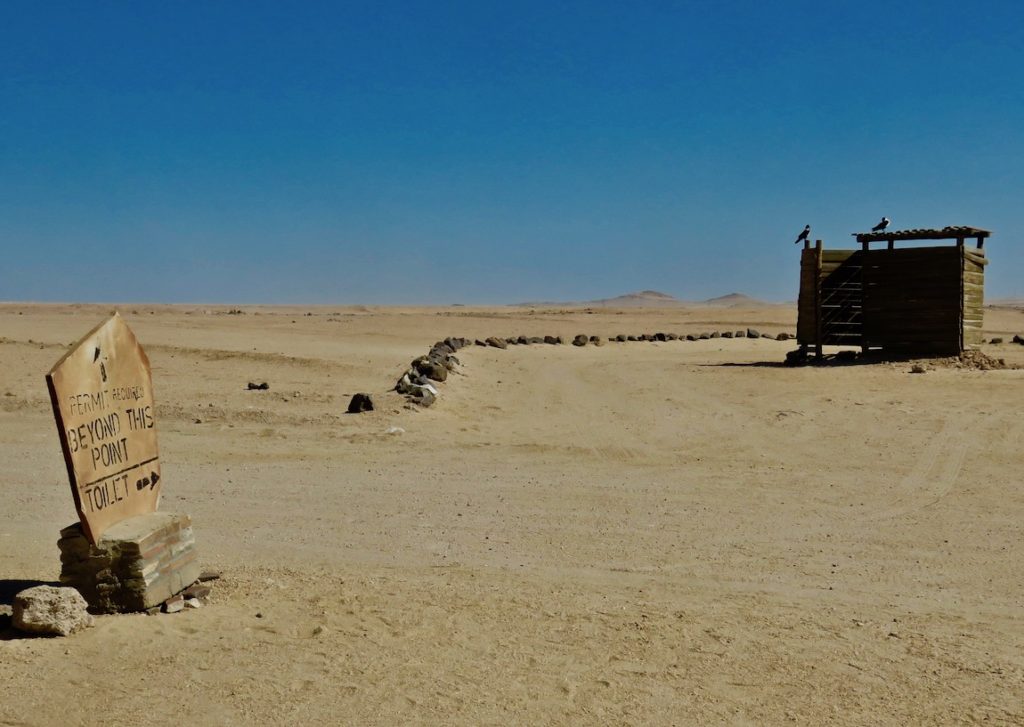
A toilet in the desert (Photo Elsa Dixon)
We were scarcely back on the main road when we blinked at the sight of lakes of blue water and flocks of pink flamingos! We marveled at the mirage of blue and pink and then drove into the deep-sea harbor town of Walvis Bay. Unexpectedly, the desert sands met the ocean.
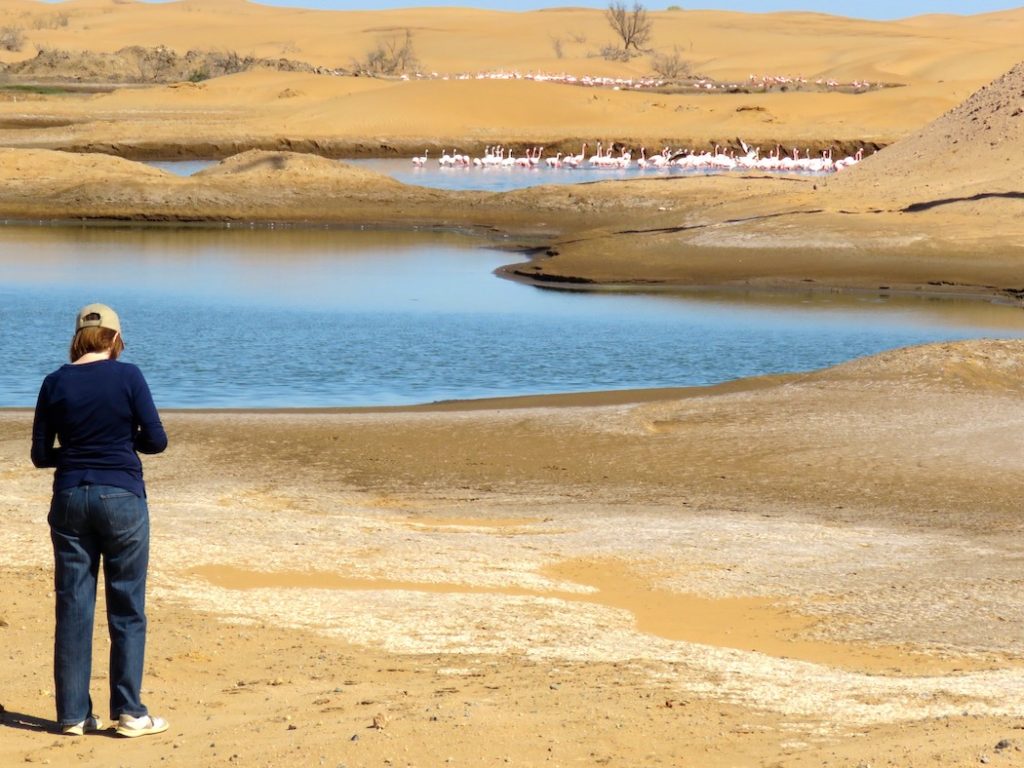
And suddenly, flamingos en route (Photo Elsa Dixon)
We stopped at The Raft Restaurant, pitched on a jetty and surrounded by the Atlantic Ocean. The cold beer and light lunch went down well, and we could not get enough of seeing the expanse of blue water! We had time to explore, and the lagoon at the edge of the town beckoned. We thrilled at the sight of hundreds of pelicans and pink flamingoes. Driving out of town, we came across a unique golf driving range, consisting of sandbanks, not a blade of grass in sight. As the would-be golfers hit the shots, a Namibian fellow would trudge through the sand to collect the balls in his bucket.
A 30-minute drive further and we reached Swakopmund, another German colonial town and a popular tourist destination. Our spacious suites at the Aha Beach Hotel had stunning ocean views, and the service and meals were excellent.
Day 6: Historical Swakopmund and Jurassic Welwitschia Plains
The hotel is close to the center of historical Swakopmund, where the half-timbered houses and buildings erected during the 19th century bears evidence of the German colonial influence. Swakopmund is a very popular beach destination. The Information Center is beautifully set up with great examples of different crafts and products that Swakopmund has to offer.
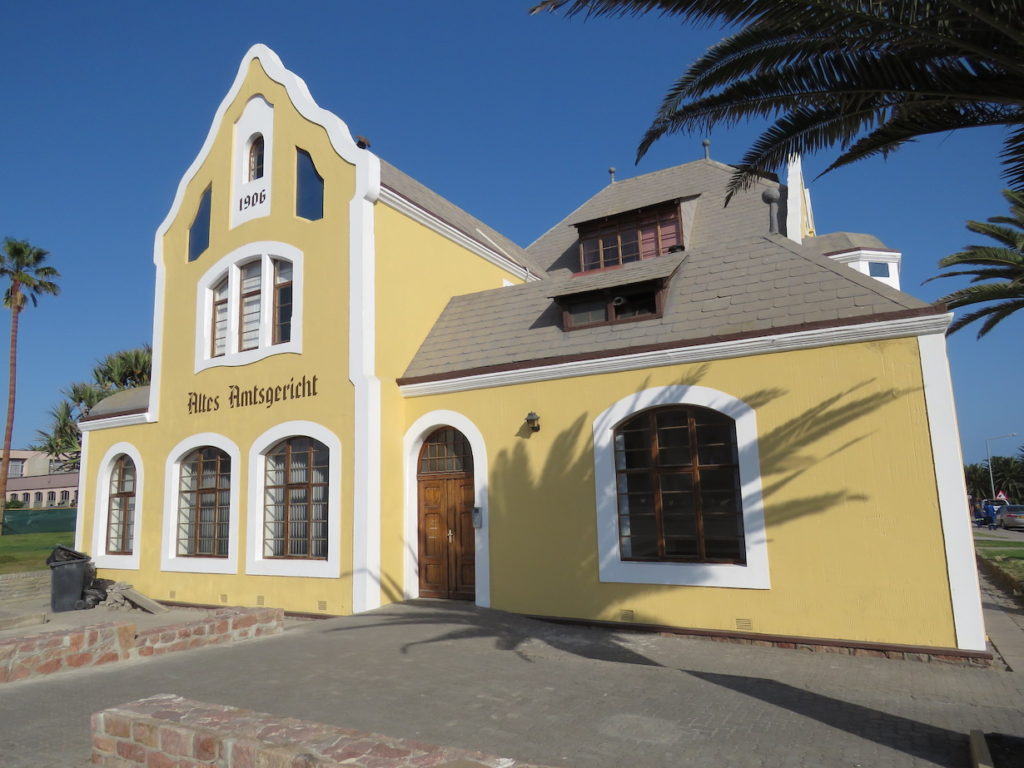
Swakopmund on our Namibia road trip (Photo Elsa Dixon)
We booked a half-day tour through Kallisto Tours and Services to see the Welwitschia plant, a living fossil found only in the Namib Desert. Some plants are between 1000 and 1500 years old. The driver-guide, Hans-Dieter Goethje, picked us up at the hotel, and just off the C28, turned in to Moon Valley, a strange lunar-like landscape formed about 500 million years ago. We stopped to admire relics of a camp set up by a patrol during the First World War. And we also saw the tracks of ox wagons that transported goods almost a century ago.
We had a short respite in the cool shade at Goanikontes Oasis in the Swakop River Valley before proceeding on very sandy roads past a few isolated farms to the Welwitschia Plains. These plants originated in the Jurassic period, and are trees that grow underground, consisting of a stem, two leaves, and a long taproot. A plant is either male or female. The two leaves grow continuously along the ground, becoming frayed after centuries of being exposed to wind, erosion, and weather conditions. They have unique structures on their leaves that catch the dew during the night. Welwitschias are protected and should not be disturbed at all.
After such a full day, we were in bed early that night!
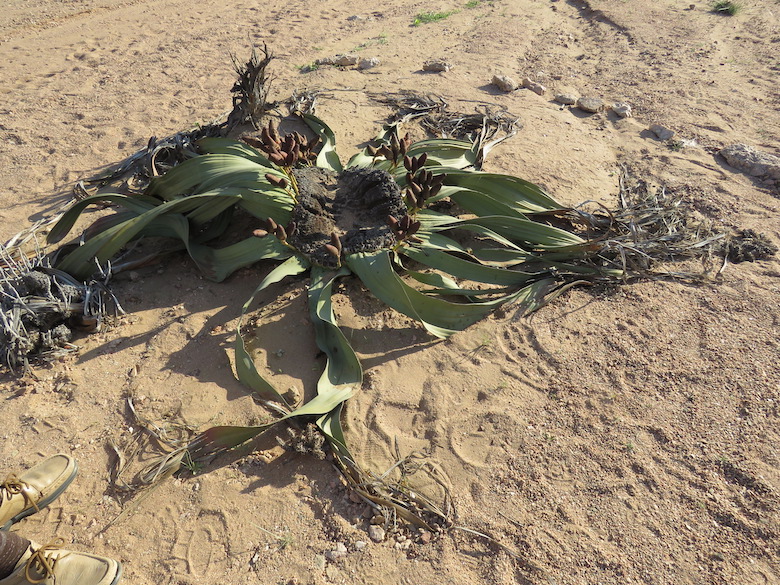
A Welwitschia plant (Photo Elsa Dixon)
Day 7: Full Circle on Our Namibia Road Trip
We were ready to head back to Windhoek, a distance of about 223 miles on the B2. We passed through small towns with names like Usakos, Karibib, and Okahandja. After one hour driving, however, we turned off on the D1918 to visit the Spitzkoppe Mountain, a prominent landmark. We stopped at a small village where the indigenous Damara people sell their colorful wares and semi-precious stones. We had an eye-opening experience pumping water with our feet at the solitary toilet facility. On arrival at Spitzkoppe, we secured a guide who took us on a short walking tour to view some Bushman (San) paintings.
Late afternoon, we booked into Ondekaremba Lodge on a game farm only a 10-minute-drive away from the Hosea Kutako airport. We were thoroughly amused by a large family of ground squirrels that popped up their heads from boroughs under the ground. They did this precisely like meerkats do. We did mistake them for meerkats at first!
That evening, a welcoming fire was burning in the dining room, and we enjoyed a delicious home-cooked meal and some lovely South African wines. Our stay in Namibia and our Namibia road trip was complete as we would be flying off to Botswana very early the next morning.
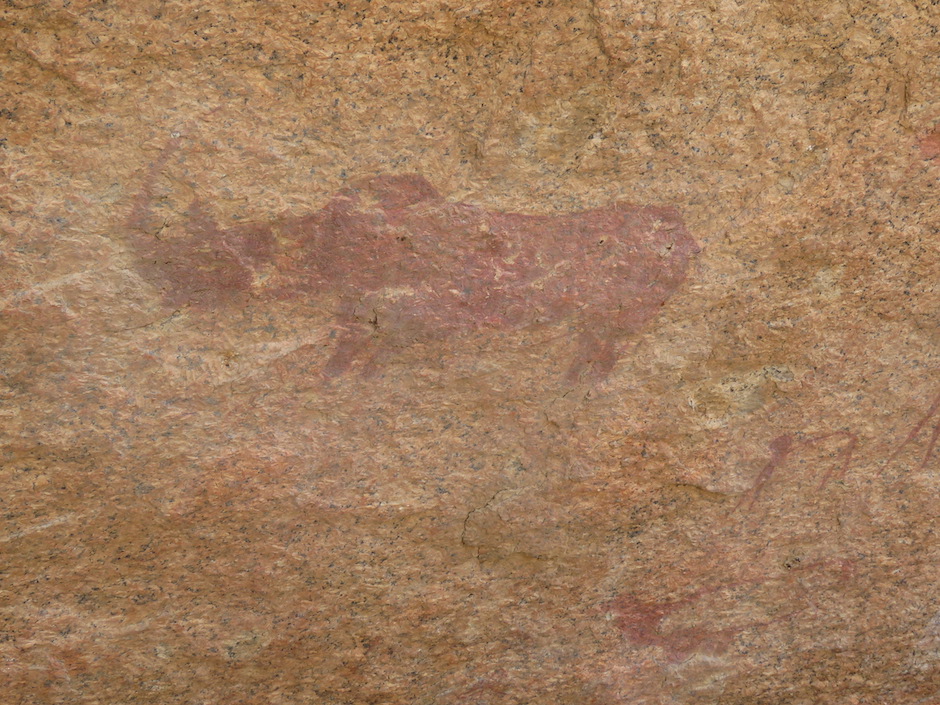
Bushman art (Photo by Elsa Dixon)
For More:
- Hilltop Guesthouse, Windhoek, Namibia, https://www.hilltop.com.na/
- Joe’s Beerhouse, Windhoek, Namibia, https://www.joesbeerhouse.com/
- The Raft Restaurant, The Esplanade, The Lagoon, Walvis Bay WB1, Namibia
- Aha Beach Hotel Swakopmund, https://www.beach-hotel-swakopmund.com/
- Kallisto Tours and Services, Tour Guide: Hans-Dieter Goethje, https://kallisto.com.na/welcome/
- Ondekaremba Lodge, 7 km from International Airport, Windhoek, Namibia, https://www.ondekaremba.com/index.html
- Independence Memorial Museum, Windhoek, Namibia (free admission)
- Gondwana Namib Desert Lodge, https://www.gondwana-collection.com/
- Sossusvlei map, https://www.visitingnamibia.com/sossusmaps.html
- Namibia Tourism: https://www.namibiatourism.com.na/
- On our site: Ten Reasons You Should Travel to South Africa
- On our site: Adventures with my Camera in Stunning Namibia
Other Recommendations for Your Namibia Road Trip:
- Colonial German heritage at the ‘Tintenpalast’
- Alte Feste museum
- Bushman Art Shop & Museum
- National Art Gallery
-All photos by Elsa Dixon.

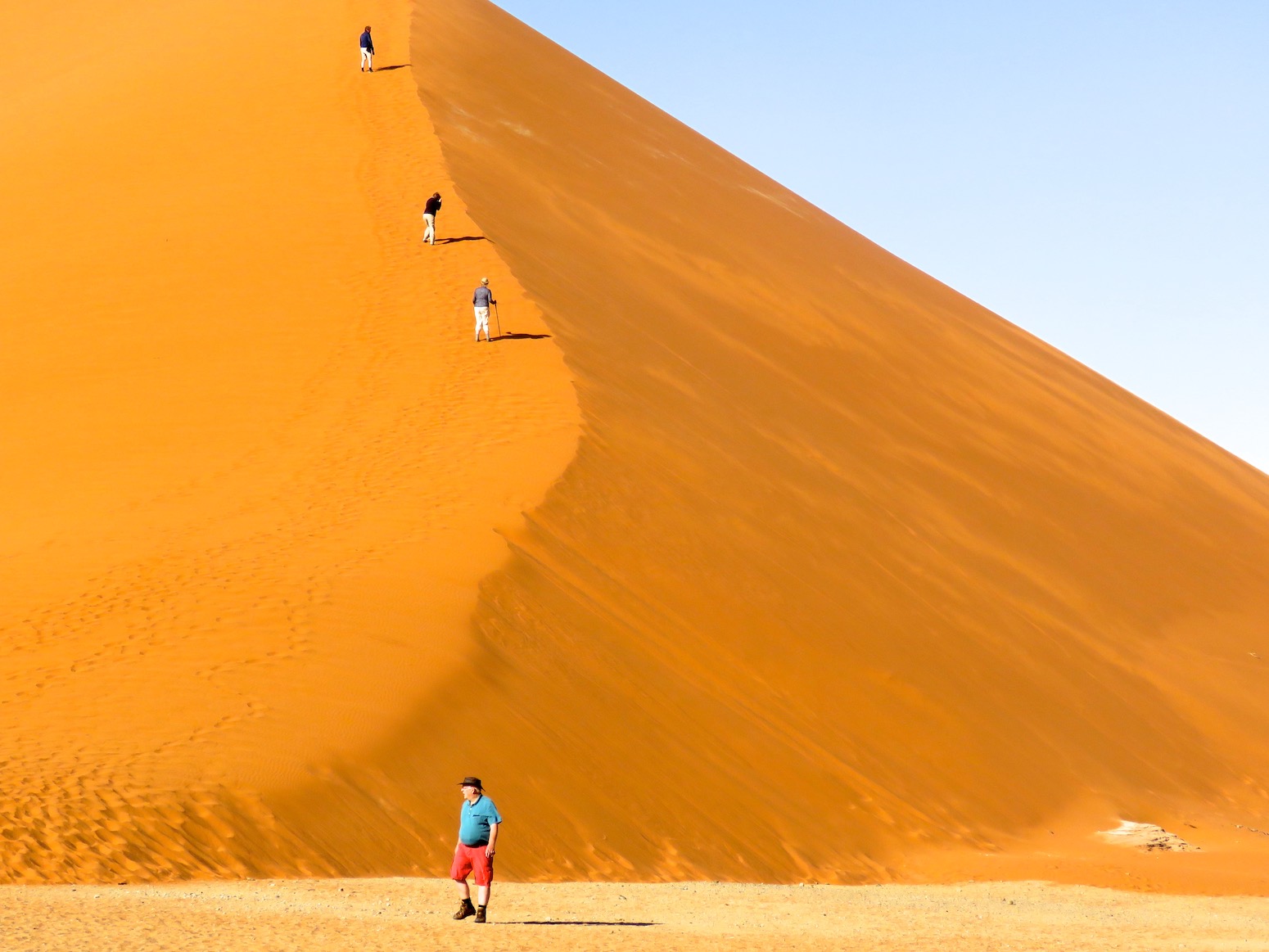

2 comments
I love your follow along day by day style. It brings your trips to life. And you go to such fascinating places!
I agree, Bitsy! I was taken with Elsa’s story as soon as I read it! As someone who also enjoys traveled to “fascinating places,” I’m really pleased to include her story on this site! Glad you liked!